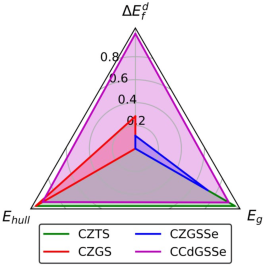Abstract
Kesterite solar cells, based on the prototypical absorber material Cu2ZnSnS4 (CZTS), are cheap, nontoxic, and chemically stable, thus rendering them promising, beyond-Si photovoltaic technologies. Their efficiencies, however, are limited by the formation of defects that decrease the short-circuit current by creating deep traps where nonradiative recombination of photoexcited charge carriers occurs via the Shockley-Read-Hall mechanism. To suppress the formation of these defects, specifically the most deleterious 2CuZn+SnZn antisite cluster, we devised an ion substitution strategy involving complete Cd- and Ge-substitution and partial selenization, ultimately arriving at the optimal composition, Cu2CdGeS3Se (CCdGSSe). Using density functional theory (DFT) and ab initio thermodynamics, we predict that complete Cd- and Ge-substitution leads to a 125% increase in the formation energy of the deep-trap-inducing 2CuCd+GeCd. Additionally, 25% selenization optimizes the predicted band gap (1.43-1.47 eV, as calculated from a hybrid functional) with respect to the Shockley-Queisser limit. In addition to providing a practical and novel ion substitution strategy, we also elucidate the mechanisms of defect suppression and promotion by Ge and Se, highlighting the key role of the inert pair effect and metal-chalcogen bond covalency, respectively. Due to its ideal thermodynamic and electronic characteristics, CCdGSSe should reinvigorate research on kesterite-based solar cells, optimizing the rich materials space afforded by ion substitution and post-quinary compositions.
